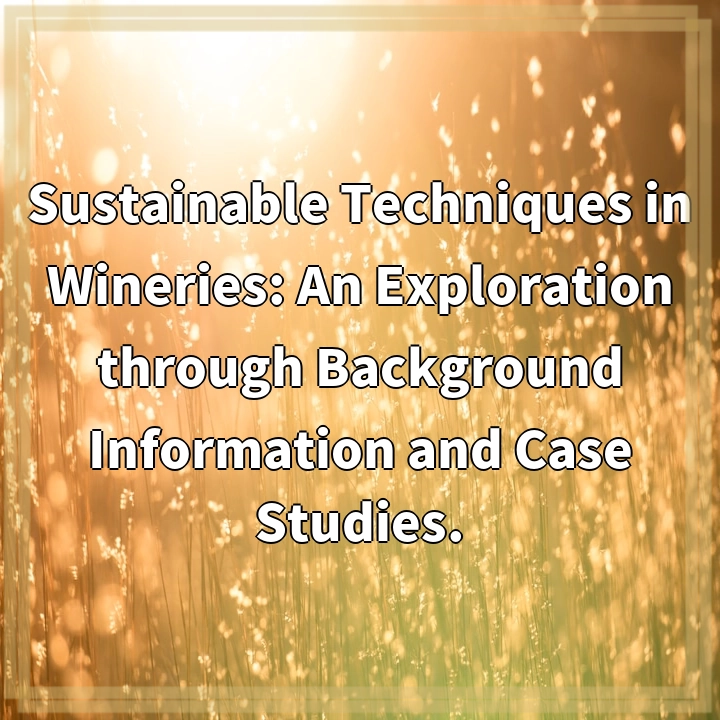
What it is:
Sustainable techniques in wineries refer to the practices and approaches implemented in the wine industry to minimize its environmental impact and promote long-term sustainability. These techniques involve various aspects of wine production, including vineyard management, water and energy conservation, waste management, and packaging choices.
Real-world problems associated with sustainable techniques in wineries:
Despite efforts towards sustainability, the wine industry faces several challenges that need to be addressed:
1. Water scarcity:
Wineries require significant amounts of water for irrigation, cleaning processes, and wine production. However, water scarcity in many wine-growing regions poses a serious challenge. Sustainable techniques aim to ensure efficient water usage and explore alternative water sources to mitigate this problem.
2. Energy consumption:
Wine production involves various energy-intensive processes, such as grape crushing, fermentation, and bottling. The reliance on fossil fuels for energy contributes to greenhouse gas emissions and climate change. Implementing renewable energy sources, energy-efficient technologies, and optimizing production processes can help reduce energy consumption in wineries.
3. Chemical use and pollution:
Pesticides, herbicides, and fertilizers used in vineyard management can pose risks to the environment, including contamination of soil, water bodies, and nearby ecosystems. Sustainable techniques aim to minimize the use of harmful chemicals through organic and biodynamic farming practices, integrated pest management, and promoting biodiversity within vineyards.
4. Waste management:
The wine production process generates substantial waste, including grape marc, pomace, and wastewater. Improper disposal of these byproducts can pollute soils and rivers, adversely impacting local ecosystems. Sustainable techniques focus on recycling, composting, and utilizing winery waste for bioenergy or other valuable products, reducing the environmental burden.
5. Packaging and carbon footprint:
Traditional wine packaging, such as glass bottles and cork closures, have a significant carbon footprint due to manufacturing, transportation, and waste disposal. Sustainable practices in wineries explore alternatives such as lightweight bottles, eco-friendly closures, and innovative packaging materials to reduce the overall environmental impact and carbon emissions associated with wine packaging.
By addressing these real-world problems and implementing sustainable techniques, wineries can contribute to environmental conservation, resource efficiency, and the overall well-being of the wine industry and the communities it operates in.

Solutions for sustainable techniques in wineries:
To address the real-world problems associated with sustainable techniques in wineries, several solutions can be implemented:
1. Water management:
Wineries can adopt advanced irrigation techniques, such as drip irrigation or precision irrigation, to optimize water usage and minimize wastage. Additionally, implementing water recycling and rainwater harvesting systems can help reduce water consumption and reliance on scarce water sources.
2. Energy efficiency:
Wineries can invest in energy-efficient technologies, such as solar panels, LED lighting, and energy-efficient winemaking equipment. Implementing energy management systems and monitoring energy usage can also help identify areas for improvement and reduce overall energy consumption in the production process.
3. Organic and sustainable farming practices:
Transitioning to organic and biodynamic farming practices can minimize the use of harmful chemicals and synthetic fertilizers. Integrated pest management techniques, such as attracting beneficial insects and employing natural predators, can help control pests more sustainably. Preserving biodiversity within vineyards can also contribute to a healthier ecosystem and minimize the need for chemical intervention.
4. Waste reduction and recycling:
Wineries can implement comprehensive waste management plans that include recycling programs, composting organic waste, and utilizing winery byproducts for bioenergy or other value-added products. Collaborating with local waste management facilities and exploring innovative techniques to reuse and repurpose winery waste can significantly reduce environmental impact.
5. Sustainable packaging alternatives:
Exploring alternative packaging materials, such as recycled glass, lightweight bottles, or eco-friendly closures, can help reduce the carbon footprint associated with wine packaging. Additionally, promoting wine packaging materials that are recyclable or biodegradable encourages consumers to make sustainable choices and reduces the environmental impact of packaging waste.
By implementing these solutions, wineries can contribute to a more sustainable and environmentally responsible wine industry. These practices not only reduce the ecological footprint but also demonstrate a commitment to protecting natural resources, promoting biodiversity, and ensuring the long-term viability of the industry.















